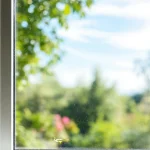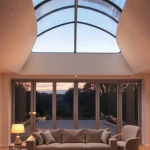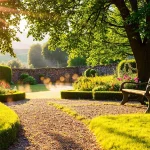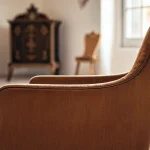Edwardian plaster ceiling roses capture the elegance and craftsmanship of a transformative architectural era. Their intricate patterns and distinctive motifs add timeless beauty and character to any interior. Appreciating these decorative plaster roses offers insight into both historical artistry and modern design trends, revealing how period plasterwork continues to inspire contemporary spaces with refined ornamental charm.
Edwardian Plaster Ceiling Roses: Iconic Designs and Inspirations
Edwardian plaster ceiling roses represent a pinnacle of period plasterwork, renowned for their intricate patterns and distinctive design motifs. These decorative plaster roses are not only visually impressive but also serve as focal points that elevate the aesthetic of interior spaces. Their craftsmanship reflects the elegance and refined tastes of the Edwardian era, combining floral and geometric elements into symmetrical, balanced compositions.
Topic to read : How Can You Transform Your Living Room with Simple UK-Inspired Decor Tips?
The variety of Edwardian ceiling rose designs is vast, ranging from simple, understated styles to elaborately detailed creations featuring layered petals, scrolls, and beadwork. This diversity allows them to complement both modest and grand interior décors. Their decorative impact extends beyond mere embellishment; they help define the character of a room by drawing attention to lighting fixtures and adding a sense of architectural depth.
For those looking to incorporate such historic charm into modern homes, Edwardian plaster ceiling roses offer an authentic touch of heritage and craftsmanship. The enduring beauty of these decorative plaster roses continues to inspire contemporary designers aiming to blend classic style with current trends. You can explore a curated image gallery showcasing these iconic designs to appreciate their complexity and visual appeal firsthand. For those interested in classic elegance with lasting impact, Edwardian Style Ceiling Roses provide an excellent reference point for period plasterwork enthusiasts.
Have you seen this : Discover the beauty of edwardian plaster ceiling roses
Historical Context and Aesthetic Significance
The Edwardian era design marks a distinctive chapter in architectural history, particularly noted for its delicate and intricate period plasterwork such as ceiling roses. These ornamental features originated as a response to the Victorian period’s heavy and elaborate styles, favoring instead a lighter, more refined aesthetic that emphasized elegance and subtlety. This evolution reflected broader cultural shifts, where the decorative arts embraced a restrained yet sophisticated charm.
Edwardian plaster roses embody this transition, showcasing floral motifs and symmetrical patterns that were popular during the period. Their design often balanced craftsmanship with an understated luxury, making them a hallmark of the era’s decorative sensibilities. The architectural history behind these roses reveals not only trends in taste but also advancements in plaster molding techniques, which allowed for more detailed and durable creations.
The ceiling rose heritage continues to influence contemporary interiors, as modern designers appreciate their timeless elegance and versatility. Their enduring appeal lies in the way these period pieces complement a variety of settings, from classic Edwardian homes to more eclectic spaces seeking a touch of historic charm. Incorporating Edwardian Style Ceiling Roses into today’s interiors connects us to a rich tradition, ensuring that this exquisite aspect of architectural history remains vibrant and relevant.
Key Design Variations of Edwardian Plaster Roses
Edwardian plaster roses present an impressive array of ceiling rose variations, each reflecting unique artistic traditions and architectural elegance. At the core of these variations lie three predominant design inspirations: classical, floral, and geometric motifs. These themes provide a rich tapestry for decorative ceiling features, shaping the ambiance of rooms in both modern and period homes.
Commonly, Edwardian styles favor circular shapes that vary in diameter from modest sizes suitable for compact rooms to grander designs that become focal points in formal spaces. The versatility in size allows these ornamental plaster features to complement diverse ceiling heights and room dimensions without overwhelming the space.
Examining the classical motifs reveals influences drawn from Greco-Roman architecture, often featuring acanthus leaves or laurel wreaths, delivering a stately and timeless impression. In contrast, floral motifs embrace naturalistic patterns such as roses, lilies, and vines, which bring a softer, more delicate aesthetic. Geometric designs, meanwhile, introduce symmetrical patterns—like interlocking circles or repeating polygons—that emphasize structure and balance.
One common question is: How have these design variations adapted to fit both modern and period homes? Primarily, the intricate details of Edwardian plaster roses have been refined and sometimes simplified to suit contemporary tastes and practical installation conditions without compromising their ornamental value. For modern residences, minimalist versions with cleaner lines and subtle textures are favored, whereas period homes often utilize more elaborate and ornate Edwardian styles to maintain historical authenticity.
For enthusiasts seeking to appreciate the charm and detail of these ceiling embellishments, exploring Edwardian Style Ceiling Roses offers a practical gateway into the wide spectrum of available designs and their applications, reinforcing the enduring appeal of ornamental plaster features.
Expert Guidance: Selecting and Restoring Edwardian Ceiling Roses
When choosing authentic Edwardian ceiling roses, it’s essential to consider both aesthetic and structural factors. The selection process should prioritize materials that closely match traditional plaster used in the Edwardian era. This guarantees that the ceiling rose not only complements the period style but also adheres to historical accuracy, maintaining architectural integrity.
A key restoration tip is to assess the condition of the existing plaster carefully. Cracks, chips, or missing elements require specialized plaster restoration techniques. These include meticulous cleaning, filling gaps with compatible plaster mixes, and sometimes casting replacement parts from molds of the original patterns. The challenge lies in balancing preservation with the need for durability, ensuring that restored roses maintain their delicate detail without compromising structural soundness.
Experts recommend integrating Edwardian ceiling roses thoughtfully into new or restored interiors to uphold the period ambiance. Positioning the rose centrally to the light fitting and harmonizing it with mouldings and cornices enhances the overall effect. Additionally, careful priming and painting safeguard the plaster while highlighting the intricate design.
For those undertaking these projects, seeking expert advice ensures both authenticity and quality. Professional guidance can assist in selecting roses that best suit the architectural style and provide tailored restoration tips for long-lasting results. To explore authentic design options, reviewing a collection of Edwardian Style Ceiling Roses can offer valuable inspiration and practical ideas for your next restoration or construction endeavor.











